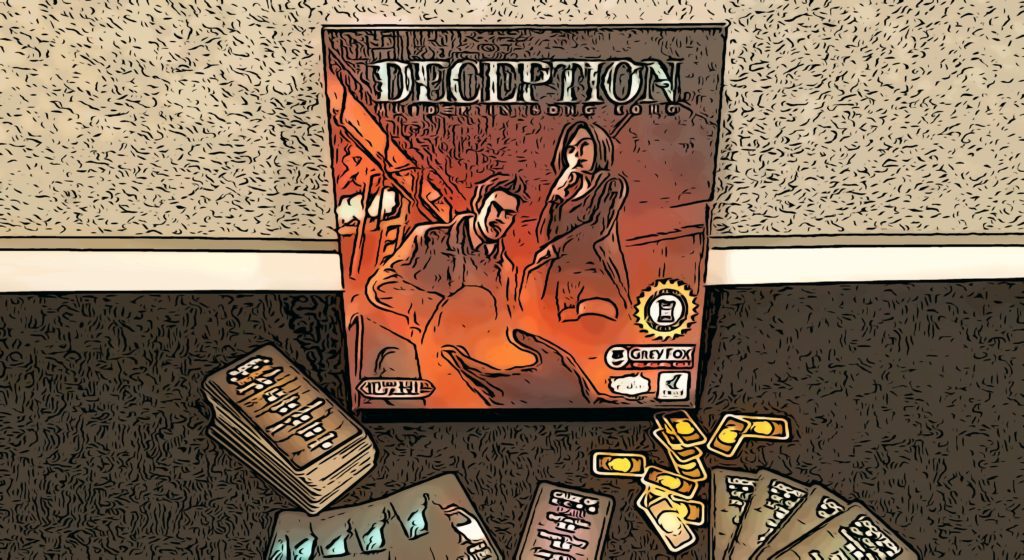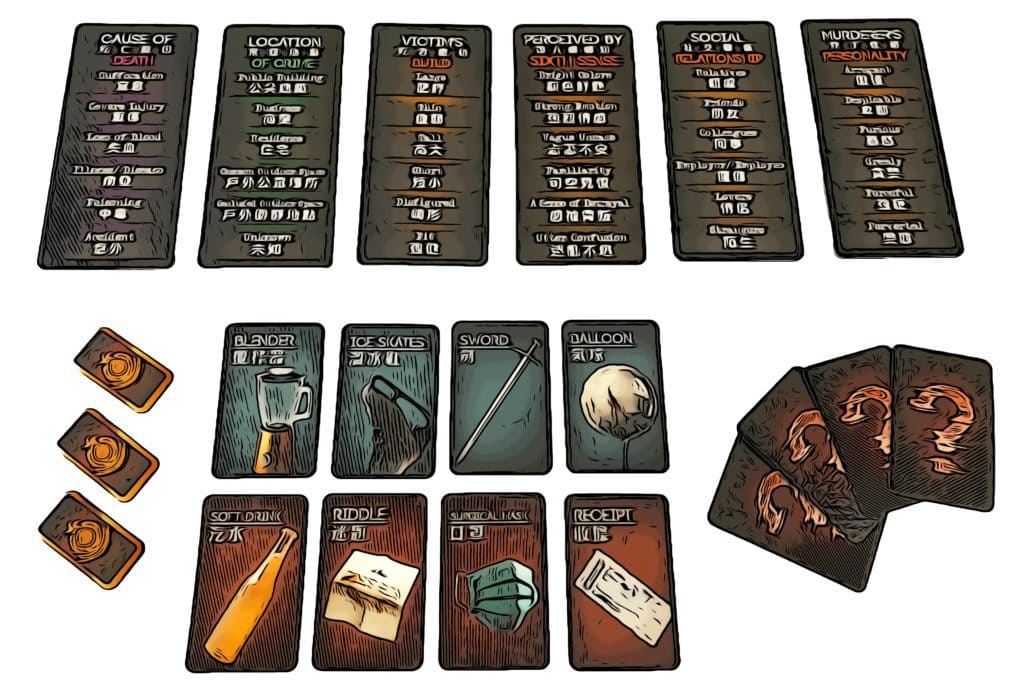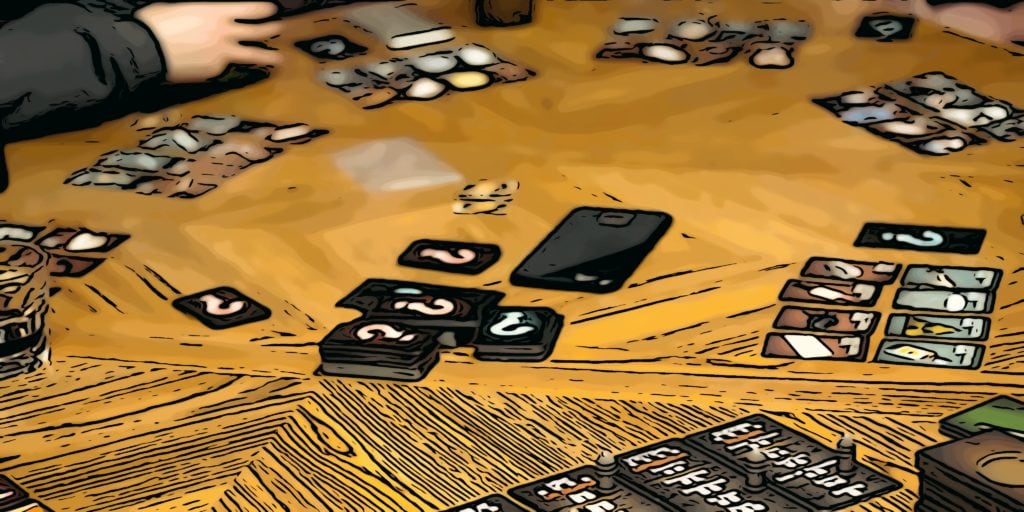
OBJECTIVE OF DECEPTION: The objective of the game is to accurately solve the murder, not only by picking the correct player as the murderer but, also correctly guessing which clue was left behind and the means of which the murder used to kill their victim.
NUMBER OF PLAYERS: 4 – 12 Players
MATERIALS: 12 black role cards, 200 red clue cards, 90 blue means cards, 32 scene tiles with 6 event tiles included, 11 badge tokens, and 6 bullet markers made of wood.
TYPE OF GAME: Murder mystery/Hidden roles game
AUDIENCE: For players 14 years and older
OVERVIEW OF DECEPTION

Deception in Hong Kong is a murder mystery game where one of the players is the murderer. Players will each have one secret roll from an investigator, witness, accomplice, or the murderer. Depending on what role you get changes your win condition.
If you are the investigator or the witness, you want to catch the murder before the end of the game. You don’t only have to guess which player the murderer is but also what they used as a murder weapon and what they left behind at the scene. There’s also the addition for the witness you have to try not to get killed by the murder and accomplice at the end of the game, while also trying to inconspicuously draw attention toward the murderer.
If you are playing the murderer or the accomplice, you want the game to end without you being properly prosecuted. If the murder does get caught you have one last chance to win if there is a witness in the game, if you kill the witness then the murderer and accomplice go free. If you are playing the accomplice, you want to draw attention away from the murder any way you can.
ROLES
Forensic Scientist (1): The forensic scientist is the player that will lead the other players through the game and give out clues to catch the murder. The forensic scientist wins with the investigators but must be an unbiased character. They know who everyone else is and the means and clue for the murder, but the forensic scientist is not permitted to hint at or give away the answer to the investigator with any gesture, verbal clue, or eyes.
Murderer (1): The murder is the character that all other players are trying to catch. You will pick your means of murder and clue from the options in front of you and try to steer player away from yourself. You may do this in any way, just remember even if people claim you are the murder you don’t lose until they guess both of your pieces of key evidence together.
Investigator (8): The investigators win if at least one of them can correctly guess the means of murder and the evidence left behind. They can do this by using the clues given by the forensic scientist, but they must keep in mind the murder and the accomplice are within their ranks and will try to steer them in the wrong direction.
All investigators will only get one chance to accuse someone.
Accomplice (1): The accomplice wins if the murderer is not convicted by the end of the game, or if the murderer correctly kills the witness. The accomplice is trying to lead the investigators away from the murder at all costs.
Witness (1): The witness wins if they or the investigators correctly identify the murder and the evidence and means that prove their guilt. The witness knows which players are playing the murderer and accomplice are but not which role they have. The witness will try to lead the investigators towards these two subtly because if they are caught and killed at the end of the game the murder goes free.
SETUP
The set up for Deception is done in three parts. There is the scene set up, the roles, and then badge tokens.
Scene
To setup the scene all event scene tile (which have blue text and paragraph information on them) should be returned to the box. These are used for a variant which can be played with in later rounds.
The second step is to shuffle the red clue cards and the blue means cards. Each player should be passed four of each of these stacks. Then players will place them face up in from of them with the card text facing out towards other players.
Players should take a moment to look at everyone’s means and clue cards, bit any art on the cards is for reference and only the text should influence investigators thought and opinions.
Roles
The next stage of set up involves the role cards. The number of investigators can change depending on the number of players.
For 5 to four player games, you will have one forensic scientist, one murderer and 2 to 3 investigators. For 6 to 12 player games, you will have one forensic scientist, one murderer, an optional Accomplice, and optional witness, and the rest will be investigators. It should be noted you can only play the witness if there is an accomplice, but the accomplice can be played without the witness.
Once the correct type and number of role cards have been acquired, they are shuffled and passed out randomly (in the first few games it is recommended to pick the forensic scientist) to each player. One the cards are dealt, the forensic scientist will reveal themselves, all other players will keep their roles secret.
The forensic scientist will then discard their clue and means cards and take the evidence tiles and shuffle them leaving the green and purple ones off to the side. The remaining tiles will be face down in a pile next to the forensic scientist. They will also get the rule book to read from the script provided.
Badge Tokens
After everything else is set up the only remaining task is to pass out badge tokens. Everyone except the forensic scientist gets a badge token, and they must be placed within eyesight of all other players in front of you. These tokens indicate that this player has not attempted to solve the crime yet.

GAMEPLAY
The game is played in multiple phases. There is the crime phase where the murder will pick their evidence against themselves, then there is the investigation which is much of the game. In the investigation, all investigators and the witness if available will attempt to find the murder and their incriminating evidence. The next portion of the case if when you solve the crime, this will be the last chance investigators can use their badge tokens to accuse someone to win the game, and finally there is the phase closing the file, this is the end game where either the investigators and witness win or the murderer and accomplice win.

Crime
The crime takes place first. The forensic scientist will read from the script in the instruction manual and inform all players to close their eyes. Then they will tell the murderer and the accomplice if there is one this game, to open their eyes.
The murder and accomplice get to know each other and then the murder will pick one clue card and one means card from the eight in front of them to be the evidence against them. The forensic scientist will need to remember these cards. After this, the forensic scientist will tell them to shut their eyes.
Then the forensic scientist will tell the witness to open their eyes if there is one and will point to the murder and accomplice without revealing which player is which. Then the forensic scientist will tell the witness to close their eyes.
All players are then informed to open their eyes. This begins the investigation phase.
Accusations
Accusations can be made during any time of the investigation by using the badge token. Look at Solving the Crime for more information.
Investigation
The investigation is the main part of the game and is separated into three rounds of play. These rounds are controlled by the Forensic Scientist and how fast they would like to give out clues. Each round has an evidence collection phase and a presentation phase and though the game can end early if an investigator correctly guesses all the needed information, the game will always end after the third round concludes.
Evidence Collection
The first round starts with evidence collection and the forensic scientist will start with the purple evidence card. This will tell the investigators how the victim was murdered. Then the forensic scientist will look through the green evidence cards and pick the one they think fits the murder the best. The green evidence cards are locations that the murder could have taken place. Then four more of the brown evidence cards from the previously shuffled pile will be pulled.
All of these evidence cards will be placed in the center of the table and the forensic scientist may begin placing the bullet markers on each tile. There may only be one marker placed on each tile and it must only be placed on one of the six spots on the tile.
The forensic scientist can take as much or as little time as they would like to place the markers on the tiles, and as soon as the first one is placed all investigators may start discussing thoughts about the evidence. Once the sixth marker is placed though, this stage of the round is over. Investigators are given a few moments more to discuss then the next stage begins.
Presentation
After the sixth marker is placed and the last piece of evidence has been discussed each player will get the chance to voice their thoughts on certain clues or means. This starts with the player left of the forensic scientist and ends with the person on their right. No one may talk or defend themselves during another players presentation. These will last about 30 seconds but can no longer dependent on what is decided before the game.
After The first round of investigation, a second round will begin. The forensic scientist will draw a new brown evidence tile and will need to replace it with one of the other tiles, it may not replace the purple and green tile. Once the tile has been replaced the forensic scientist will place the marker on the evidence they wish to present to the investigators.
After they have had a moment to discuss the new evidence the investigators will once again present their thoughts on the evidence and what it could mean for the means of murder and clues on the table.
After the second presentation is completed a third phase following the same instructions as the previous one will be initiated. After the evidence is presented and each player presents a case for the new evidence the game is over. Any unused accusations will go unused and if the murder has not been caught then they will win.
Solving the Crime
At any point during the investigation phase, a player may attempt to solve the murder. This is done by cashing in your badge token and pointing out a player and a means of murder and an evidence clue. If these are the correct evidence the forensic scientist will say yes, and the game will be over.
The investigators will win unless the witness can be guessed. If any part of the evidence is wrong, then the forensic scientist will say no. No other clues are given if the accusation is wrong. Each investigator only gets one accusation per game.
If any investigator has not used their accusation by the end of the third round of the investigation phase it is forfeited.
ENDING THE GAME
The game ends after the third round of the investigation phase whether the murderer has been caught. The following are the options of what will happen at the end of the game.
Closing the File
At the end of the game, the murder will have either been caught or will have evaded the investigators. If the murder evaded the investigators the murder and accomplice have won. If the murder was caught by pinpointing both needed pieces of evidence, then they have one more chance to win, they may discuss with their accomplice and choose a character they think the witness maybe if they are correct the murder and accomplice win. If the witness is left alive, then all investigators and forensic scientist win the game.
VARIANT
If you wish to use the variant event cards you may shuffle them into the evidence tile draw pile after the first round of evidence collection in the investigation phase. If one is pulled, then you will just simply follow the directions printed on it. If it talks about characters not in the game such as the accomplice or witness simply discard and pull another evidence tile.
- Comprehensive Guide to the Board Game Go (weiqi, baduk) - January 23, 2024
- Are Creative Suites Changing Gaming - October 30, 2023
- Crowning the Kings of Solitaire: GameRules Recognizes Solitaired and MobilityWare as top Solitaire Games - October 20, 2023